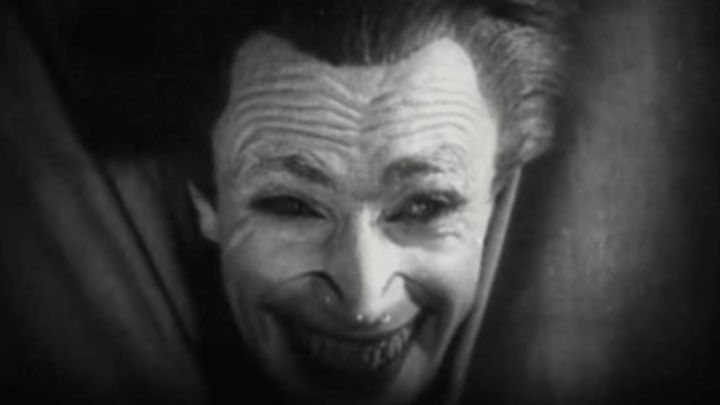How a 1928 Silent Film Influenced the Creation of the Joker

The shock of green hair. The sickly pale skin. The frozen, Cheshire grin. Everyone knows the trademarks of Batman's greatest foe, the Joker. The king of the comic book villain heap may look like a hellish circus attraction, but the origin of the character doesn't have its roots in some deep-seated fear of clowns shared by creators Bob Kane, Bill Finger, and Jerry Robinson. No, the story behind that nightmarish crimson rictus actually began with a silent German Expressionist film called The Man Who Laughs.
Based on the Victor Hugo novel of the same, the movie is about a young man named Gwynplaine (played by Conrad Veidt), whose father is sentenced to death after offending King James II. But the family's torture didn't end there; the king also ordered Gwynplaine's face be permanently disfigured into a grotesque grin, courtesy of Dr. Hardquanonne. Gwynplaine eventually grows into becoming a traveling actor, who makes money by showcasing his disfigurement to a curious public, all while falling in love with a blind woman named Dea.
Gwynplaine isn't the same homicidal lunatic that his comic book doppelgänger is, but take one look at Veidt's makeup and it's easy to see where the idea for the Clown Prince of Crime started to form. The way Batman creator Bob Kane told the story, the Veidt inspiration was there from the very beginning:
"Bill Finger and I created the Joker. Bill was the writer. Jerry Robinson came to me with a playing card of the Joker. That's the way I sum it up. But he looks like Conrad Veidt — you know, the actor in The Man Who Laughs, [the 1928 movie based on the novel] by Victor Hugo. There's a photo of Conrad Veidt in my biography, Batman & Me. So Bill Finger had a book with a photograph of Conrad Veidt and showed it to me and said, 'Here's the Joker.'"
Well that's Kane's recollection of the Joker's creation, anyway. However, there's some debate over how much of a contribution each man made to the character's first appearance in Batman #1. Robinson has gone on record saying he created the character almost from the ground up before it was tweaked to look more like Gwynplaine only after Finger showed him an image of Veidt in costume. Until his dying day, Kane insisted Robinson's main contribution was the character's namesake calling card design and little else. In the early days of comics, you'd be hard-pressed to find any two creators agree on who came up with which character, but the influence The Man Who Laughs had on the Joker's origin can't be questioned.
How intertwined is the character of Gwynplaine in the Joker's history? Sixty-five years after the Joker's debut, DC Comics released a graphic novel depicting the character's first run-in with the Dark Knight. The book's title? Batman: The Man Who Laughs (which could make a great gift for a film lover). In the book, writer Ed Brubaker and artist Doug Mahnke took the Joker back to his roots, with a visual depiction of the character that is almost indistinguishable from Gwynplaine. Even Heath Ledger's take on Joker from The Dark Knight took a note from Hugo's creation by portraying his frozen smile as the result of scarred disfigurement, rather than simply being the byproduct of his unhinged temperament, like it has been in the comics in the past.
In the nearly 80 years since his debut, the Joker has evolved. And we'll see yet another interpretation of the character, courtesy of Joaquin Phoenix, when The Joker arrives in theaters this week. Yet the character still owes his very existence to the ghoulish grin Veidt brought to the screen back in 1928.
This article was originally published in 2016 and has been updated.